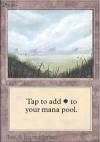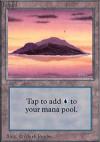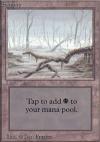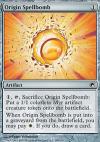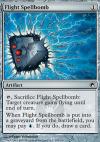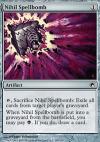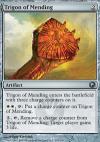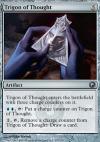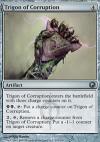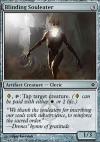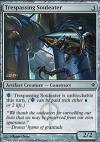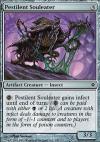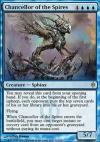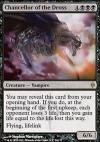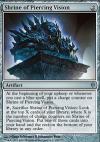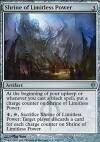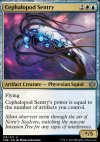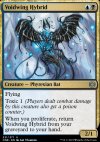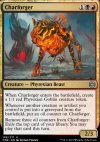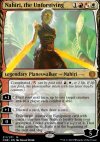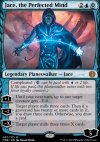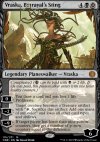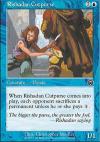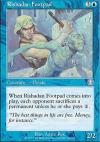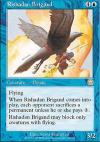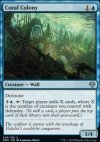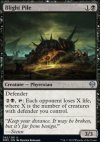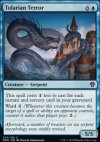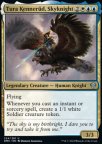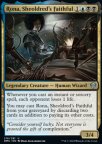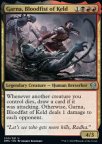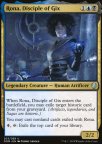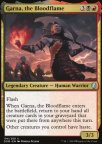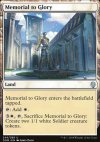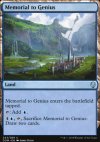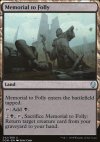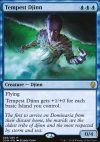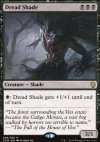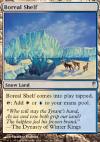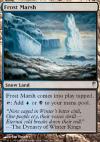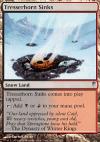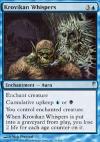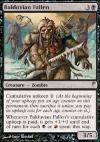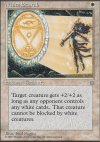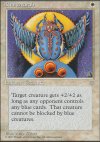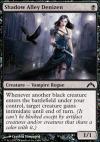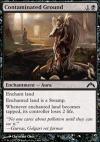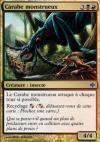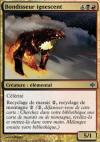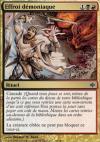|

MV anecdotes
| 938 anecdotes trouvées |   |
Les cinq cartes Plains, Island, Swamp, Mountain et Forest forment le cycle de terrains de base, complété du cycle de leurs équivalents enneigés.
Chacun d'entre eux est associé à une des couleurs de mana ,
,  ,
,  ,
,  et
et  , notées W, U, B, R et G en abréviations (basées sur les noms des couleurs en anglais) et en suivant l'ordre des couleurs du pentagone au dos des cartes. Ainsi, par convention, les cycles de cartes (voir cette série d'anecdotes) impliquant une carte par couleur sont décrits en les classant dans le même ordre WUBRG, comme on peut le constater sur le jeton Everywhere.
, notées W, U, B, R et G en abréviations (basées sur les noms des couleurs en anglais) et en suivant l'ordre des couleurs du pentagone au dos des cartes. Ainsi, par convention, les cycles de cartes (voir cette série d'anecdotes) impliquant une carte par couleur sont décrits en les classant dans le même ordre WUBRG, comme on peut le constater sur le jeton Everywhere.
Source 1 - Source 2 (WUBRG - "WUBRG stands for White, Blue, Black, Red, Green - the five colors in R&D order (the order by which we list the colors in our files).") - Source 3
Chacun d'entre eux est associé à une des couleurs de mana
 ,
,  ,
,  ,
,  et
et  , notées W, U, B, R et G en abréviations (basées sur les noms des couleurs en anglais) et en suivant l'ordre des couleurs du pentagone au dos des cartes. Ainsi, par convention, les cycles de cartes (voir cette série d'anecdotes) impliquant une carte par couleur sont décrits en les classant dans le même ordre WUBRG, comme on peut le constater sur le jeton Everywhere.
, notées W, U, B, R et G en abréviations (basées sur les noms des couleurs en anglais) et en suivant l'ordre des couleurs du pentagone au dos des cartes. Ainsi, par convention, les cycles de cartes (voir cette série d'anecdotes) impliquant une carte par couleur sont décrits en les classant dans le même ordre WUBRG, comme on peut le constater sur le jeton Everywhere.Source 1 - Source 2 (WUBRG - "WUBRG stands for White, Blue, Black, Red, Green - the five colors in R&D order (the order by which we list the colors in our files).") - Source 3
Les cinq cartes Origin Spellbomb, Flight Spellbomb, Nihil Spellbomb, Panic Spellbomb et Horizon Spellbomb, de l'édition Scars Of Mirrodin et illustrées par Franz Vohwinkel, forment un cycle appelé "Spellbomb", inspiré de celui paru dans l'édition Mirrodin (voir cette anecdote).
Les cinq cartes Trigon of Mending, Trigon of Thought, Trigon of Corruption, Trigon of Rage et Trigon of Infestation, de l'édition Scars Of Mirrodin, forment un cycle appelé "Trigon", chacun étant rattaché à une couleur.
On relève aussi que les trigones blanc, bleu et rouge sont liés à la faction Mirrane, alors que les trigones noir et vert (soit les couleurs dans lesquelles on retrouve la majorité des cartes avec la capacité Infection) sont liés à la faction Phyrexiane.
On relève aussi que les trigones blanc, bleu et rouge sont liés à la faction Mirrane, alors que les trigones noir et vert (soit les couleurs dans lesquelles on retrouve la majorité des cartes avec la capacité Infection) sont liés à la faction Phyrexiane.
Les cinq cartes Blinding Souleater, Trespassing Souleater, Pestilent Souleater, Immolating Souleater et Insatiable Souleater, de l'édition New Phyrexia, forment un cycle appelé "Souleater".
Les cinq cartes Chancellor of the Annex, Chancellor of the Spires, Chancellor of the Dross, Chancellor of the Forge et Chancellor of the Tangle, de l'édition New Phyrexia, forment un cycle appelé "Chancellor".
Les cinq cartes Shrine of Loyal Legions, Shrine of Piercing Vision, Shrine of Limitless Power, Shrine of Burning Rage et Shrine of Boundless Growth, de l'édition New Phyrexia, forment un cycle de reliquaires, chacun étant rattaché à une couleur.
Sur l'illustration de chacun, on aperçoit Karn, dans sa version corrompue par les Phyrexians, avant qu'il ne devienne Karn Liberated.
Sur l'illustration de chacun, on aperçoit Karn, dans sa version corrompue par les Phyrexians, avant qu'il ne devienne Karn Liberated.
Les dix cartes Cephalopod Sentry, Voidwing Hybrid, Charforger, Cinderslash Ravager, Slaughter Singer, Vivisection Evangelist, Serum-Core Chimera, Necrogen Rotpriest, Bladehold War-Whip et Tainted Observer, de l'édition Phyrexia: All Will Be One, forment un cycle de permanents bicolores peu communs soutenant chacun un archétype de formats limités.
Source 1 (Rogue ONE - "Here's how the ten two-color archetypes ended up") - Source 2 ("Draft, as an example, had a big influence on the uncommon gold cards that model Draft archetypes")
Source 1 (Rogue ONE - "Here's how the ten two-color archetypes ended up") - Source 2 ("Draft, as an example, had a big influence on the uncommon gold cards that model Draft archetypes")
Citation :
Here's how the ten two-color archetypes ended up:
White-blue (artifacts) – The Phyrexians have always been tied to artifacts, so it only seemed right to have one draft archetype focus on them. Blue is primary in "artifact matters" and white is secondary, so those two colors seemed like the best choices.
Blue-black (proliferate control) – Blue is one of oil counter colors. Black is one of the poison counter colors. Put the two of them together, and you have your normal manipulative blue-black deck, but now with a dose of counters and proliferate.
Black-red (oil counters and sacrifice) – Sacrifice is a common black-red archetype. The set adds in oil counters to the mix and creates a two-color combination that feels quite Phyrexian, as they see death as a valuable tool.
Red-green (midrange oil counters) – Red and green are both oil counter colors and are the two colors that care most about how many permanents you have with oil counters. This theme works well with a deck that grows in strength over time as you gain in mana and oil counters.
Green-white (toxic aggro) – Green and white are two of the three poison colors. This deck makes a horde of creatures with toxic, including the Mite creature tokens, and swarms for a poison win.
White-black (corrupted) – White and black are the two colors with the most corrupted cards, so they come together to poison your opponent just enough to make your cards even more powerful.
Blue-red (oil counters and noncreature spells) – This deck uses your noncreature spells to gain more and more oil counters, which then create effects to help you win this tempo strategy.
Black-green (poison victory) – Black and green are the two colors with the largest toxic creatures. Get them out and win in just a few hits.
Red-white (For Mirrodin! Equipment) – Red and white are the two colors with the most Rebels in it. Use the Equipment with the For Mirrodin! keyword to aggressively attack.
Green-blue (proliferate and poison) – Green has a lot of cards that poison. Blue and green are both good at proliferating. Poison your opponent and then slowly proliferate them to death. This is the most controlling of the poison decks.
White-blue (artifacts) – The Phyrexians have always been tied to artifacts, so it only seemed right to have one draft archetype focus on them. Blue is primary in "artifact matters" and white is secondary, so those two colors seemed like the best choices.
Blue-black (proliferate control) – Blue is one of oil counter colors. Black is one of the poison counter colors. Put the two of them together, and you have your normal manipulative blue-black deck, but now with a dose of counters and proliferate.
Black-red (oil counters and sacrifice) – Sacrifice is a common black-red archetype. The set adds in oil counters to the mix and creates a two-color combination that feels quite Phyrexian, as they see death as a valuable tool.
Red-green (midrange oil counters) – Red and green are both oil counter colors and are the two colors that care most about how many permanents you have with oil counters. This theme works well with a deck that grows in strength over time as you gain in mana and oil counters.
Green-white (toxic aggro) – Green and white are two of the three poison colors. This deck makes a horde of creatures with toxic, including the Mite creature tokens, and swarms for a poison win.
White-black (corrupted) – White and black are the two colors with the most corrupted cards, so they come together to poison your opponent just enough to make your cards even more powerful.
Blue-red (oil counters and noncreature spells) – This deck uses your noncreature spells to gain more and more oil counters, which then create effects to help you win this tempo strategy.
Black-green (poison victory) – Black and green are the two colors with the largest toxic creatures. Get them out and win in just a few hits.
Red-white (For Mirrodin! Equipment) – Red and white are the two colors with the most Rebels in it. Use the Equipment with the For Mirrodin! keyword to aggressively attack.
Green-blue (proliferate and poison) – Green has a lot of cards that poison. Blue and green are both good at proliferating. Poison your opponent and then slowly proliferate them to death. This is the most controlling of the poison decks.
Les cinq cartes Nahiri, the Unforgiving, Jace, the Perfected Mind, Vraska, Betrayal's Sting, Lukka, Bound to Ruin et Nissa, Ascended Animist, de l'édition Phyrexia: All Will Be One et illustrées par Chase Stone, forment un cycle.
Source 1 (Two for ONE - Ichormoon Gauntlet - "Phyrexia: All Will Be One has more planeswalkers in it than any set, save War of the Spark, (five normal planeswalkers and five compleated planeswalkers)") - Source 2 (The Compleated Planeswalkers)
Source 1 (Two for ONE - Ichormoon Gauntlet - "Phyrexia: All Will Be One has more planeswalkers in it than any set, save War of the Spark, (five normal planeswalkers and five compleated planeswalkers)") - Source 2 (The Compleated Planeswalkers)
Les cartes Sensor Splicer, Master Splicer et Blade Splicer forment un cycle vertical (cartes d'une même couleur mais avec une rareté différente) de l'édition New Phyrexia.
Elles sont complétées par Wing Splicer, Vital Splicer et Maul Splicer, de la même édition, pour former un cycle appelé "Splicer" et constitué uniquement de cartes blanches, bleues et vertes.
Les cartes Splicer's Skill, Ich-Tekik, Salvage Splicer, Darksteel Splicer et Vexyr, Ich-Tekik's Heir parues ensuite font référence à ce cycle.
Elles sont complétées par Wing Splicer, Vital Splicer et Maul Splicer, de la même édition, pour former un cycle appelé "Splicer" et constitué uniquement de cartes blanches, bleues et vertes.
Les cartes Splicer's Skill, Ich-Tekik, Salvage Splicer, Darksteel Splicer et Vexyr, Ich-Tekik's Heir parues ensuite font référence à ce cycle.
Les cartes Rishadan Cutpurse, Rishadan Footpad et Rishadan Brigand forment un cycle vertical (cartes d'une même couleur mais avec une rareté différente) de l'édition Mercadian Masques.
Les deux cartes Coral Colony et Blight Pile, de l'édition Dominaria United, forment une paire de créatures peu communes avec le défenseur et une capacité activée liée au nombre de créatures avec le défenseur que vous contrôlez.
À noter, la formulation de la capacité est légèrement différente et ce, au sein de la même édition.
À noter, la formulation de la capacité est légèrement différente et ce, au sein de la même édition.
Les cinq cartes Argivian Phalanx, Tolarian Terror, Writhing Necromass, Molten Monstrosity et Yavimaya Sojourner, de l'édition Dominaria United, forment un cycle.
Les dix cartes Tura Kennerüd, Skyknight, Rona, Sheoldred's Faithful, Garna, Bloodfist of Keld, Rulik Mons, Warren Chief, Queen Allenal of Ruadach, Aron, Benalia's Ruin, Najal, the Storm Runner, Uurg, Spawn of Turg, Tori D'Avenant, Fury Rider et Tatyova, Steward of Tides, de l'édition Dominaria United, forment un cycle de créatures légendaires bicolores peu communes soutenant chacune un archétype de formats limités.
Source 1 ("When you combine these five themes, you get the ten two-color archetypes") - Source 2 ("Draft, as an example, had a big influence on the uncommon gold cards that model Draft archetypes")
Source 1 ("When you combine these five themes, you get the ten two-color archetypes") - Source 2 ("Draft, as an example, had a big influence on the uncommon gold cards that model Draft archetypes")
Citation :
When you combine these five themes, you get the ten two-color archetypes:
White-blue – This is the combination of go-wide with instants and sorceries, so it's focused on generating a lot of tokens, protecting them, and then boosting them. Go wide strategies aren't traditionally done in white-blue, so this is pushing into novel space.
Blue-black – This is the combination of instants and sorceries and death. The end result is a control deck that uses card advantage to slowly eke out a victory.
Black-red – This is the combination of death and aggression. This results in aggressive creature strategy where you're rewarded for having your creatures die.
Red-green – This is the combination of aggression and ramp, so it's a mid-range creature deck that makes use of some domain cards.
Green-white – This is the combination of domain and go wide. This deck splashes extra colors to use domain as a tool to reinforce your attacking army.
White-black – This is go-wide plus death, which means it's a deck about creating a lot of small creatures that you then sacrifice for value. This ends up being a slower controlling deck than most go-wide strategies.
Blue-red – This combines instants and sorceries with aggression. That leads to a tempo-based spell deck.
Black-green – This combines death and ramp. This results in a mid-range deck that makes use of the graveyard.
Red-white – This combines aggression with go-wide that results in a typical aggro creature-based strategy, red-white's bread and butter.
Green-blue – This combines ramp/domain with instants and sorceries. It results in a base green-blue deck that splashes two to three colors and makes use of big domain effects.
White-blue – This is the combination of go-wide with instants and sorceries, so it's focused on generating a lot of tokens, protecting them, and then boosting them. Go wide strategies aren't traditionally done in white-blue, so this is pushing into novel space.
Blue-black – This is the combination of instants and sorceries and death. The end result is a control deck that uses card advantage to slowly eke out a victory.
Black-red – This is the combination of death and aggression. This results in aggressive creature strategy where you're rewarded for having your creatures die.
Red-green – This is the combination of aggression and ramp, so it's a mid-range creature deck that makes use of some domain cards.
Green-white – This is the combination of domain and go wide. This deck splashes extra colors to use domain as a tool to reinforce your attacking army.
White-black – This is go-wide plus death, which means it's a deck about creating a lot of small creatures that you then sacrifice for value. This ends up being a slower controlling deck than most go-wide strategies.
Blue-red – This combines instants and sorceries with aggression. That leads to a tempo-based spell deck.
Black-green – This combines death and ramp. This results in a mid-range deck that makes use of the graveyard.
Red-white – This combines aggression with go-wide that results in a typical aggro creature-based strategy, red-white's bread and butter.
Green-blue – This combines ramp/domain with instants and sorceries. It results in a base green-blue deck that splashes two to three colors and makes use of big domain effects.
Les dix cartes Raff Capashen, Ship's Mage, Rona, Disciple of Gix, Garna, the Bloodflame, Hallar, the Firefletcher, Shanna, Sisay's Legacy, Arvad the Cursed, Adeliz, the Cinder Wind, Slimefoot, the Stowaway, Tiana, Ship's Caretaker et Tatyova, Benthic Druid, de l'édition Dominaria, forment un cycle de créatures légendaires bicolores peu communes soutenant chacune un archétype de formats limités.
Source 1 - Source 2 ("Draft, as an example, had a big influence on the uncommon gold cards that model Draft archetypes")
Source 1 - Source 2 ("Draft, as an example, had a big influence on the uncommon gold cards that model Draft archetypes")
Citation :
[...] This time around, we are taking a look at the Limited archetypes in Dominaria.
[...] we usually start out with the gold uncommons in the set. These gold uncommons can often act as sort of signposts for what each color pair is trying to do in that set.[...]
White-Blue Historic Fliers
Blue-Black Value
Black-Red Sacrifice Aggro
Red-Green Kicker Ramp
Green-White Tokens
White-Black Legendary
Blue-Red Wizards
Black-Green Saproling Sacrifice
Red-White Auras and Equipment
Green-Blue (sic)
[...] That was a whirlwind look at all ten archetypes in Dominaria Limited.
[...] we usually start out with the gold uncommons in the set. These gold uncommons can often act as sort of signposts for what each color pair is trying to do in that set.[...]
White-Blue Historic Fliers
Blue-Black Value
Black-Red Sacrifice Aggro
Red-Green Kicker Ramp
Green-White Tokens
White-Black Legendary
Blue-Red Wizards
Black-Green Saproling Sacrifice
Red-White Auras and Equipment
Green-Blue (sic)
[...] That was a whirlwind look at all ten archetypes in Dominaria Limited.
Les cinq cartes Memorial to Glory, Memorial to Genius, Memorial to Folly, Memorial to War et Memorial to Unity, de l'édition Dominaria, forment un cycle de terrains appelé "Memorial".
Les cinq cartes Benalish Marshal, Tempest Djinn, Dread Shade, Goblin Chainwhirler et Steel Leaf Champion, de l'édition Dominaria, forment un cycle.
Les cinq cartes Boreal Shelf, Frost Marsh, Tresserhorn Sinks, Highland Weald et Arctic Flats, de l'édition Coldsnap, forment un cycle de terrains neigeux. De plus leurs textes d'ambiance se font écho et sont tous en rimes.
Source ("Coldsnap had a cycle of five ally color snow dual lands that entered the battlefield tapped.")
Source ("Coldsnap had a cycle of five ally color snow dual lands that entered the battlefield tapped.")
Les cinq cartes Jötun Owl Keeper, Krovikan Whispers, Balduvian Fallen, Earthen Goo et Arctic Nishoba, de l'édition Coldsnap, forment un cycle.
Les cinq cartes White Scarab, Blue Scarab, Black Scarab, Red Scarab et Green Scarab, de l'édition Ice Age, forment un cycle appelé "Scarab".
Les cinq cartes Court Street Denizen, Sage's Row Denizen, Shadow Alley Denizen, Foundry Street Denizen et Ivy Lane Denizen, de l'édition Gatecrash, forment un cycle appelé "Denizen".
Les cinq cartes Debtor's Pulpit, Skygames, Contaminated Ground, Tin Street Market et Verdant Haven, de l'édition Gatecrash, forment un cycle.
Les cinq cartes Glassdust Hulk, Architects of Will, Monstrous Carabid, Deadshot Minotaur et Sigil of the Nayan Gods, de l'édition Alara Reborn, forment un cycle de sorts bicolores communs avec une capacité de Recyclage pour un coût de un mana hybride correspondant à leurs deux couleurs.
Source (Alara Reborn - "There was also a common cycle that had cycling using a single hybrid mana. The idea was that you would play it in a deck with both colors, but if you don't draw one of them, you can cycle the card away.")
Source (Alara Reborn - "There was also a common cycle that had cycling using a single hybrid mana. The idea was that you would play it in a deck with both colors, but if you don't draw one of them, you can cycle the card away.")
Les cinq cartes Sanctum Plowbeast, Jhessian Zombies, Igneous Pouncer, Valley Rannet et Pale Recluse, de l'édition Alara Reborn, forment un cycle de créatures bicolores avec la capacité Recyclage d'un terrain de base des deux sous-types correspondant à leurs deux couleurs.
Les cinq cartes Stormcaller's Boon, Deny Reality, Demonic Dread, Violent Outburst et Captured Sunlight, de l'édition Alara Reborn, forment un cycle de sorts non-créature bicolores communs associés aux couleurs alliées, possédant tous la capacité Cascade.
| 938 anecdotes trouvées |   |






 Tarkir: Dragonstorm
Tarkir: Dragonstorm Aetherdrift
Aetherdrift Foundations
Foundations Duskmourn
Duskmourn Bloomburrow
Bloomburrow Modern Horizons III
Modern Horizons III Outlaws of Thunder Junction
Outlaws of Thunder Junction